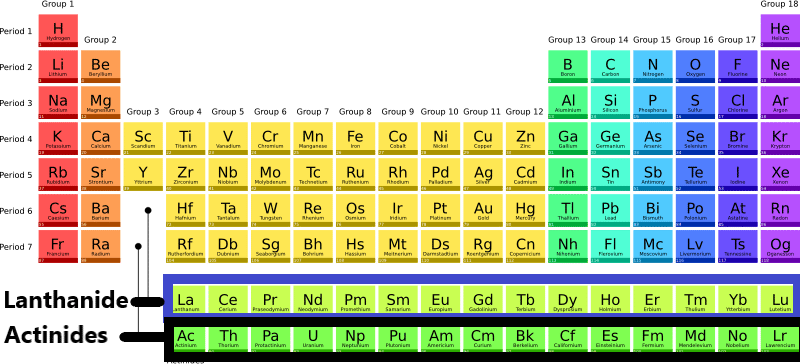Table of Contents
ToggleLanthanides and Actinides are inner-transition elements. Since the last electron i.e. differentiating electron in the atoms of these elements enters the f-subshell belonging to the anti-penultimate shell, these elements are also called f-block elements. Lanthanides are the elements of 6th period of the periodic table ranging from Ce58 to Lu71 in which the last electron enters into the anti-penultimate 4f sub-shell. However, Actinides are the elements from Ac89 to Lw103 in which the last electron enters into the anti-penultimate 5f sub-shell. They are present in the 7th period of the periodic table.
The name lanthanides and actinides have been given since these elements follow La57and Ac89 respectively with which these elements show close similarities. The general electronic configuration of lanthanides and actinides are:
Lanthanides: [Xe] 4f1-14 5d10-1 6s2
Actinides: [Xe] 5f0-14 6d0-1 7s2

Lanthanides and Actinides properties
Some of the common properties of lanthanides and actinides are:
- The elements of both the series have vacant d and f shells.
- Although the majority of lanthanides and actinides are rare in nature, Ce, La, Nd, and Th are abundant.
- The lanthanides have similar chemical properties, and so have the actinides. Additionally, there are certain similarities between the elements of both series in terms of their chemical reactivity.
- Among the elements in the two series (Lanthanides and Actinides), the trivalent state is common and stable. However, some of them exhibit variable valency.
- Since the majority of the ions of lanthanides and actinides have spin-free electrons, they are paramagnetic.
- All the metals are chemically reactive.
- Unlike common metals like Fe, Ni, and Zn, the metals exhibit poor mechanical properties.
- Several elements of both the series exhibit Polymorphism.
- They form coordination compounds, just like transition metals do. However, the lanthanides and actinides do not form as many complexes as transition metals do. Most of their complexes are chelates.
- There is a contraction in the size of ions in both series (lanthanide contraction and actinide contraction).
- In comparison to those of the typical transition ions, the spectral absorption bands of the ions of these elements are narrow (sharp). The f electrons are protected by the outer electrons, and the ligands have little effect on the f-electrons, which is explained by the fact that the electronic energy changes involved in these are caused by excitation within the f-shells.
Differences between Lanthanides and Actinides
- The majority of lanthanides are found in nature, however, most actinides are synthetic.
- The actinides’ spectral lines are about 10 times as strong as the lanthanides’.
- Though all actinides, like lanthanides, have a +III oxidation state, it is not the most stable state for all of them, particularly for the first four actinides-Th, Pa, U, and NP. In comparison to lanthanides, the most stable +IV state is so far more common.
- The actinides’ 5f orbitals extend beyond the 6s and 6p orbitals into space and takes part in bonding. In lanthanides, on the other hand, the 4f orbitals are buried deep within the atom, completely shielded by outer orbitals and hence unable to participate in bonding. In earlier actinide elements, the 5f orbitals participate in bonding, resulting in higher oxidation states (Th, Pa, U, and NP). As a result, actinides have a wider range of oxidation states, ranging from +2 to +7, whereas lanthanides only have a range of +2 to +4.
Lanthanides and Actinides Video
References
- J. D. Lee, Concise Inorganic Chemistry, 5th Edition, John Wiley and Sons. Inc. 2007.
- F. A. Cotton, G. Wilkinson & C. Gaus, Basic Inorganic Chemistry, 3 rd Edition, John Wiley & Sons (Asia), Pvt., Ltd., 2007.
- D. F. Shriver & P. W. Atkins, Inorganic Chemistry, 5th Edition, Oxford University Press, 2010.






